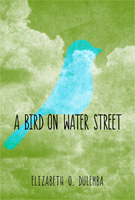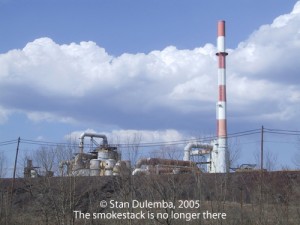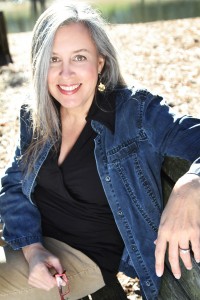Guest post By Elizabeth O. Dulemba
When my novel A BIRD ON WATER STREET sold to Little Pickle Press, I hadn’t looked at it for a while. In fact, it was in a drawer when the acquiring editor said (in response to a younger book I was pitching), “You know what we’re really looking for is an environmental novel. You don’t have one of those lying around do you?” As a matter of fact, I did . . .
A BIRD ON WATER STREET is a coming of age story about Jack, a boy growing up in a Southern Appalachian town environmentally devastated by a century of poor copper-mining practices and pollution. Jack is opposed to the mine where so many of his relatives have died, but how can he tell that to his Dad who wants him to follow in the family trade? Jack just wants his dad safe and the land returned to its pre-mining glory with trees, birds, frogs, and nature—like he’s learning about in school. After Jack’s uncle is killed in a mining accident and the Company implements a massive layoff, the union organizes and the miners go on strike. It seems Jack’s wish is coming true, nature begins to creep back. But the cost may be the ruin of his home and everything he loves.
It was definitely an environmental novel.
But I had put A BIRD ON WATER STREET in a drawer, after what I know now, was only a handful of rejections. Pah! Maybe it was for the best, though. As the manuscript sat, I grew in my craft. I studied and wrote and became a better writer. I knew that someday I’d go back to the story and would tackle it with objective and more skilled eyes, which is exactly what happened.
At Little Pickle Press, I also got to work with a great editor—Tanya Egan Gibson. I’ve been working in critique groups and with first readers long enough to know a good editor when I come across one. Not everybody has the chops to do it, even if their intentions are good. It takes more than just giving positive feedback. It takes being able to pull out the problems and perhaps even suggest solutions.
With Tanya’s help, we deconstructed A BIRD ON WATER STREET. I often refer to the exercise as taking apart a jigsaw puzzle and putting it back together again upside-down and backwards. That’s what it felt like anyhow.
One of my biggest issues was that I had saved much of the good stuff for later in the book —it got great towards the end. Why was I saving all that and not employing it from the start? I attribute it to the timidity of a beginning writer. (I started writing A BIRD ON WATER STREET ten years ago, almost at the beginning of my career.) So much of the information needed to move forward, which fixed the other problem of a saggy middle, where not much was happening.
 The opening was trickiest of all as the story originally began with Jack’s arm cast being removed. It was dramatic, sure, but readers need to build sympathy for a character before the drama can mean something to them. To do that, they needed to get to know Jack first. The book now opens with Jack in class studying trees—the thing he wants most in his environmentally devastated home.
The opening was trickiest of all as the story originally began with Jack’s arm cast being removed. It was dramatic, sure, but readers need to build sympathy for a character before the drama can mean something to them. To do that, they needed to get to know Jack first. The book now opens with Jack in class studying trees—the thing he wants most in his environmentally devastated home.
I also like to think I’ve become a better sentence crafter. I write pretty simply: subject, verb, direct object, without too much fluff—like Hemingway (ha!). I stay away from convoluted constructions, complicated tenses, and too much flowery description. I lean on dialogue to relay the personality of my characters. And I always try to feel a rhythm with my text. In fact, I’ll often lose my voice after a day of editing from reading out loud, making sure the beats work, the language flows, and the energy ticks off exactly as I want it to.
To be honest, revisions are my favorite part of the writing process, because that’s when you can add the nuances and the small details that mean so much. I was lucky to have the chance to go back and edit with my more developed skill set. And happily, it seems to be paying off with my audience . . .
I’ve been humbled and flattered by the amazing reviews it’s received. After ten years of plugging and rewriting and revising, I’m thrilled to finally share A BIRD ON WATER STREET with the world!
Book Blurb:
When the birds return to Water Street, will anyone be left to hear them sing? A miner’s strike allows green and growing things to return to the Red Hills, but that same strike may force resi-dents to seek new homes and livelihoods elsewhere. Follow the story of Jack Hicks as he strug-gles to hold onto everything he loves most.
Early Recognition for the Book
- Southern Independent Booksellers Alliance (SIBA) Okra Pick
- Gold Mom’s Choice Award Winner
- 2014 National Book Festival Featured Title for the state of Georgia in Washington, D.C.
Bio
 Elizabeth O. Dulemba is an award-winning children’s book author/illustrator with two dozen titles to her credit. She is Illustrator Coordinator for the SCBWI Southern region, a Board Mem-ber for the Georgia Center for the Book, and Visiting Associate Professor at Hollins University in the MFA in Children’s Book Writing and Illustrating program. A BIRD ON WATER STREET is her first novel (Spring 2014, Little Pickle Press). Learn more at http://dulemba.com.
Elizabeth O. Dulemba is an award-winning children’s book author/illustrator with two dozen titles to her credit. She is Illustrator Coordinator for the SCBWI Southern region, a Board Mem-ber for the Georgia Center for the Book, and Visiting Associate Professor at Hollins University in the MFA in Children’s Book Writing and Illustrating program. A BIRD ON WATER STREET is her first novel (Spring 2014, Little Pickle Press). Learn more at http://dulemba.com.
Thanks so much for having me on Darcy! :) e
Thank you both. Yes, always a work in progress and it is always interesting to read what other writers are doing as they continue going forward.
I agree Mary! :)